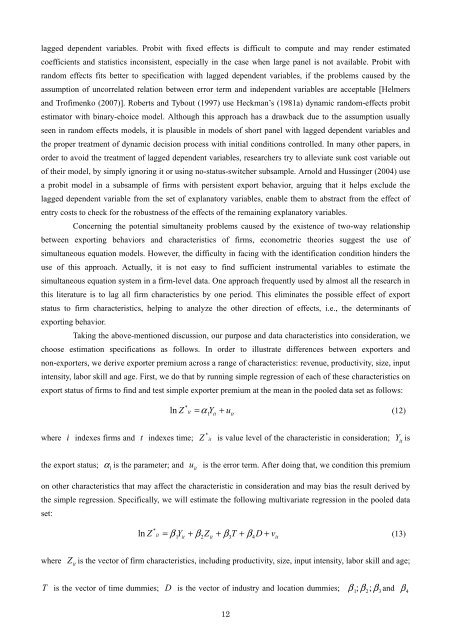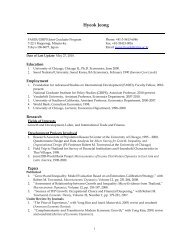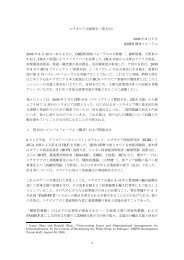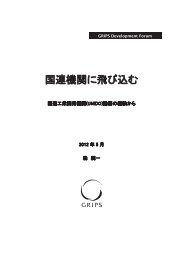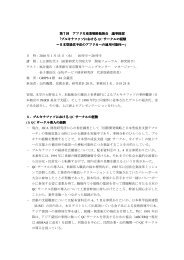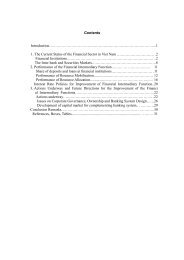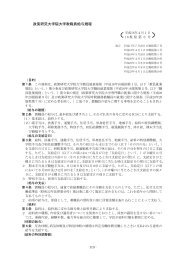Evidence from Firm-level Data in Vietnam
Evidence from Firm-level Data in Vietnam
Evidence from Firm-level Data in Vietnam
You also want an ePaper? Increase the reach of your titles
YUMPU automatically turns print PDFs into web optimized ePapers that Google loves.
lagged dependent variables. Probit with fixed effects is difficult to compute and may render estimatedcoefficients and statistics <strong>in</strong>consistent, especially <strong>in</strong> the case when large panel is not available. Probit withrandom effects fits better to specification with lagged dependent variables, if the problems caused by theassumption of uncorrelated relation between error term and <strong>in</strong>dependent variables are acceptable [Helmersand Trofimenko (2007)]. Roberts and Tybout (1997) use Heckman’s (1981a) dynamic random-effects probitestimator with b<strong>in</strong>ary-choice model. Although this approach has a drawback due to the assumption usuallyseen <strong>in</strong> random effects models, it is plausible <strong>in</strong> models of short panel with lagged dependent variables andthe proper treatment of dynamic decision process with <strong>in</strong>itial conditions controlled. In many other papers, <strong>in</strong>order to avoid the treatment of lagged dependent variables, researchers try to alleviate sunk cost variable outof their model, by simply ignor<strong>in</strong>g it or us<strong>in</strong>g no-status-switcher subsample. Arnold and Huss<strong>in</strong>ger (2004) usea probit model <strong>in</strong> a subsample of firms with persistent export behavior, argu<strong>in</strong>g that it helps exclude thelagged dependent variable <strong>from</strong> the set of explanatory variables, enable them to abstract <strong>from</strong> the effect ofentry costs to check for the robustness of the effects of the rema<strong>in</strong><strong>in</strong>g explanatory variables.Concern<strong>in</strong>g the potential simultaneity problems caused by the existence of two-way relationshipbetween export<strong>in</strong>g behaviors and characteristics of firms, econometric theories suggest the use ofsimultaneous equation models. However, the difficulty <strong>in</strong> fac<strong>in</strong>g with the identification condition h<strong>in</strong>ders theuse of this approach. Actually, it is not easy to f<strong>in</strong>d sufficient <strong>in</strong>strumental variables to estimate thesimultaneous equation system <strong>in</strong> a firm-<strong>level</strong> data. One approach frequently used by almost all the research <strong>in</strong>this literature is to lag all firm characteristics by one period. This elim<strong>in</strong>ates the possible effect of exportstatus to firm characteristics, help<strong>in</strong>g to analyze the other direction of effects, i.e., the determ<strong>in</strong>ants ofexport<strong>in</strong>g behavior.Tak<strong>in</strong>g the above-mentioned discussion, our purpose and data characteristics <strong>in</strong>to consideration, wechoose estimation specifications as follows. In order to illustrate differences between exporters andnon-exporters, we derive exporter premium across a range of characteristics: revenue, productivity, size, <strong>in</strong>put<strong>in</strong>tensity, labor skill and age. First, we do that by runn<strong>in</strong>g simple regression of each of these characteristics onexport status of firms to f<strong>in</strong>d and test simple exporter premium at the mean <strong>in</strong> the pooled data set as follows:ln Z + u*it = α 1Yitit(12)*where i <strong>in</strong>dexes firms and t <strong>in</strong>dexes time; Z it is value <strong>level</strong> of the characteristic <strong>in</strong> consideration; Yitisthe export status; α1is the parameter; anduitis the error term. After do<strong>in</strong>g that, we condition this premiumon other characteristics that may affect the characteristic <strong>in</strong> consideration and may bias the result derived bythe simple regression. Specifically, we will estimate the follow<strong>in</strong>g multivariate regression <strong>in</strong> the pooled dataset:ln Z β Z + β T + β D + v(13)*it =1Yit+ β2it3 4 itwhereZitis the vector of firm characteristics, <strong>in</strong>clud<strong>in</strong>g productivity, size, <strong>in</strong>put <strong>in</strong>tensity, labor skill and age;T is the vector of time dummies; D is the vector of <strong>in</strong>dustry and location dummies; β1; β2;β3and β412


